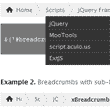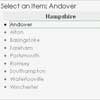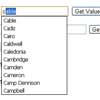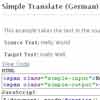#jQuery Github Widget
###Questions?
For general questions, find me on Twitter. For issues or feature requests and general questions, please use the issues page.
###Usage
Using the GitHub widget is super simple, you just need to include the script after the core jQuery library and then set it up in the following way within the <head> of your page and tell it which element on the page you want the widget to appended to:
<script src="jquery.min.js"></script> <script src="jquery.github.min.js"></script> <script type="text/javascript"> $(document).ready(function(){ $("#some-element").github({ user: "joepettersson" }); }); </script> The only required option is the user name of the Github user you want the widget to represent. You don't have to worry about capitalisation, as the plugin normalises the username.
Note: if you do not specify a username when running the plugin, it will list me instead, as I a set as the default.
If you want use the default style for the widget, and I assume you do, then you also need to include the provided stylesheet and image sprite (within this repo).
###Options
All of the options specified below are optional and do not need to be set in order for the plugin to work. However, described below are the full set of different options, their accepted parameters and their type:
$("#some-element").github({ user: "joepettersson", show_extended_info: true, show_follows: true, width: "400px", show_repos: 10, oldest_first: false }); #####Show extended info show_extended_info Accepted parameters: true/false
Within the header of the Github widget is the users avatar (if it exists), when hovering over it a menu pops up showing extended info for that user. This behaviour can be turned off by setting this option to false.
#####Show follows show_follows Accepted parameters: true/false
Underneath the users name in the header of the widget is an area displaying the number of followers the user has. This behaviour can be turned off by setting this parameter to false.
#####Width width Accepted parameters: A string representing a custom width for the widget, in CSS compliant units (px/%/em/pt)
The default width of the widget is 400px, and I wouldn't recommend setting this below about 250px as the layout starts to look a little weird.
#####Show repos show_repos Accepted parameters: number/integer
The number of repos you wish to display within the widget, with a maximum of 30. This is a limit set by Github for one page of their API, you can get more but if you want to show more than 30 in a simple widget like this you're probably not getting the best use out of it anyway. The default is 10.
#####Oldest first oldest_first Accepted parameters: true/false
As a default the widget prints a users repos with the recent first, as they are provided by Github, but if you would like to reverse the order (showing the oldest first) you should set this parameter to true.
#####Customer sorter sorter Accepted parameters: function/null
In case you want to use custom sorting to promote certain repos to the top of the widget you can pass in a custom sort function. Example:
$(document).ready(function(){ var _opt = { sorter: function(a, b) { if (a.fork && b.fork) return 0; if (a.fork) return 1; if (b.fork) return -1; return 0; }, }; $("#insert-here").github(); $("#insert-here2").github(_opt); }); ###FAQ
Q. Can I have more than one widget per page?
A. Yes. No problem, just attach them to more than one element on the page.
Q. What browsers does this function in?
A. This widget functions properly in modern browsers, and the default style uses many CSS3 features that will not work for legacy browsers (<IE9 I'm looking at you!). However, I've made some effort to support legacy browsers in the CSS so it shouldn't look too crappy. Apart from that there is no reason it shouldn't work fine in legacy browsers.
Q. Should I strive to achieve all my goals in life and sacrifice a social life or breeze through life having fun?
A. Only questions related to the plugin please. I'm not your therapist. But the second one.
###Contributing
- Fork
- Do yo' thang
- Send pull request
Notes and requirements for contributing:
- All code must be linted.
- All contributions must have tests.
- You must run the build command to minify
srcbefore submitting pull request.
###Building and Testing This scripts build and test process is based on the NodeJS toolchain, so NodeJS and NPM being installed are prerequisities.
The tests are also run with PhantomJS, so it will need to be installed first, if it isn't already, to do so in OSX with the awesome HomeBrew package manager just run the following command:
brew install phantomjs When you have Node/NPM/Phantom installed, you can use the following commands to build the script:
git clone https://github.com/JoePettersson/jquery-github-widget.git cd jquery-github-widget npm install grunt Running the final grunt command will lint the JavaScript, run the tests and minify the JavaScript and CSS into the dist directory.
If you just wish to run the tests, you can run the following command form the project root:
grunt jasmine 






































































